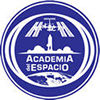 |
Laboratory
Module
|
 |
 |
Laboratory
Module
|
 |
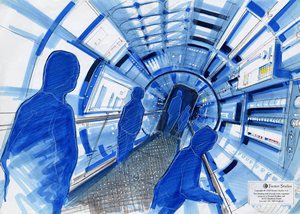
Our rotating laboratory is unique in the world.
Our intention with this element has been to provide a seven minute object theatre which shows just some of the extraordinary things that can be achieved when science is conducted in microgravity. Above all we wanted to convey a strong but simple message:-
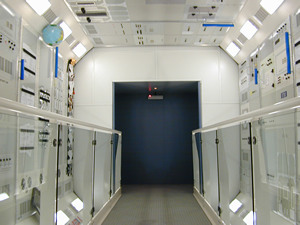
The experience is 7minutes long and is narrated by an astronaut with local ties to the venue; in the case of Valencia by Spain's Pedro Duque.
Excerpts from the script that follows can be played in any of the three language versions we have supplied to Valencia. (but please be aware that full copyright restrictions apply).
Play an excerpt in:-
“So, let's make a start.
You're in a mock-up of one of the ISS laboratory modules. Crew time is in short supply when you've got a whole space station to operate, so much if what you see around you is either automated or controlled from the ground.
When you get into space there's no way "up", but humans like to call something "up". So the first thing to notice is that all the lockers have labels and markings which point in the same direction. Now I can say to you - turn to face the way you came in and you'll find the flame box over on your right.
But, just a minute, you're gong to be weightless and floating around, so let's try to simulate that.
(Lab starts to rotate at one rev per two minutes)
Keep looking at that flame box, see how the candle turns blue instead of yellow? That's because the hot air doesn't rise - The candle no longer knows which way is up either, so it's not drawing in dust to make it turn yellow and the temperature is the same all the way around it.
80% of the energy we use on Earth is generated by burning something; coal, oil, petrol, gas. So if we can work out how to make the burning process just a few percent more efficient, we could save huge quantities of the Earth's precious energy resources.
With all this hot air around we need some pretty good fans and some very sophisticated filters.
Every breath you're taking needs to have the carbon dioxide removed, and the moisture must be saved. This is a closed biosphere; we can't just open the windows and there's no rain water to collect.
Oh! - there's my pencil, I knew it wouldn't be on the floor!
Here's a drop of that precious water. It behaves strangely in micro-gravity doesn't it. We astronauts spent a lot of time just mopping up on the Russian MIR station, to prevent mould growing and eventual corrosion, but, together, we've learned that lesson now.
Let's take a look at the plants we're growing up here.
If we're going to head further out into space we're not going to be able to take all our food with us, we're going to have to grow it. (The oxygen which plants supply is going to come in handy too!).
But whilst we're learning how to farm in micro-gravity we're finding that our plants are producing new fragrances, their seeds are more resilient to crop failure and they are helping us find more natural ways of combating human disease.
These little pots contain important drug research too. We're growing protein crystals inside them and protein crystals are the building blocks of life. The most fragile of crystals can grow to an enormous size in micro-gravity because they don't break under their own weight.
Once we return these to Earth aboard the next visiting shuttle they will teach us more about the complex chemistries going on inside our bodies and enable us to better fight many forms of infectious or degenerative diseases like cancer and osteoporosis.
Even the process of being in space is teaching us so much.
There's a laptop open over there. It controls some of the systems on board, ground control can send us documents attached to email, our families can stay in touch with us and, if we've worked to the timeline all day we might even get to watch half a movie on DVD. There are dozens of laptops open on the station right now and there's nobody around to fix them except us!
Finally, it's not just inside the station that we're finding out new things. Take a look out of the window at an early materials experiment.
It's dangerous out here in orbit. Unfiltered radiation from the sun will give you more than just a suntan. Then there's the debris; even a speck of dust can pack quite a punch when its travelling at 27,000 km/hr.
Out on the balcony there we've left a whole variety of different paints, coatings and insulation material to study which fare best over a long period of time in this hostile environment, all of which of course has applications on earth.
Right now there are three crew on the station. Soon we hope to have seven. But to do that we need a bigger lifeboat. So, we're asking you volunteers to ride the experimental crew return vehicle.
The shuttle takes it up, you ride it back.
Make your way to the shuttle cargo bay and good luck.”
Getting to sleep is just as important as it is on Earth when you've got another full days work ahead.
We don't mind all this background machinery noise but we soon wake up if it changes. The sleeping bag has a pair of holes for the arms. The first time it feels awkward to wake up and find your hands floating around in front of you, but you get used to it very quickly.
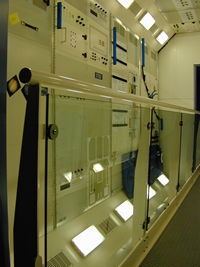
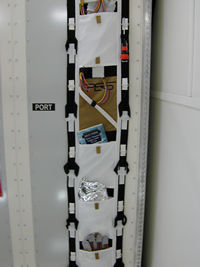
PERS
Talking about fixing things - this is the Personal Equipment Restraint, or PERS.
Even opening the simplest panel probably involves a screwdriver and four screws. Where do you put them so that they don't all end up in the air vent?
Well, some students came up with this idea and now we couldn't do without it.